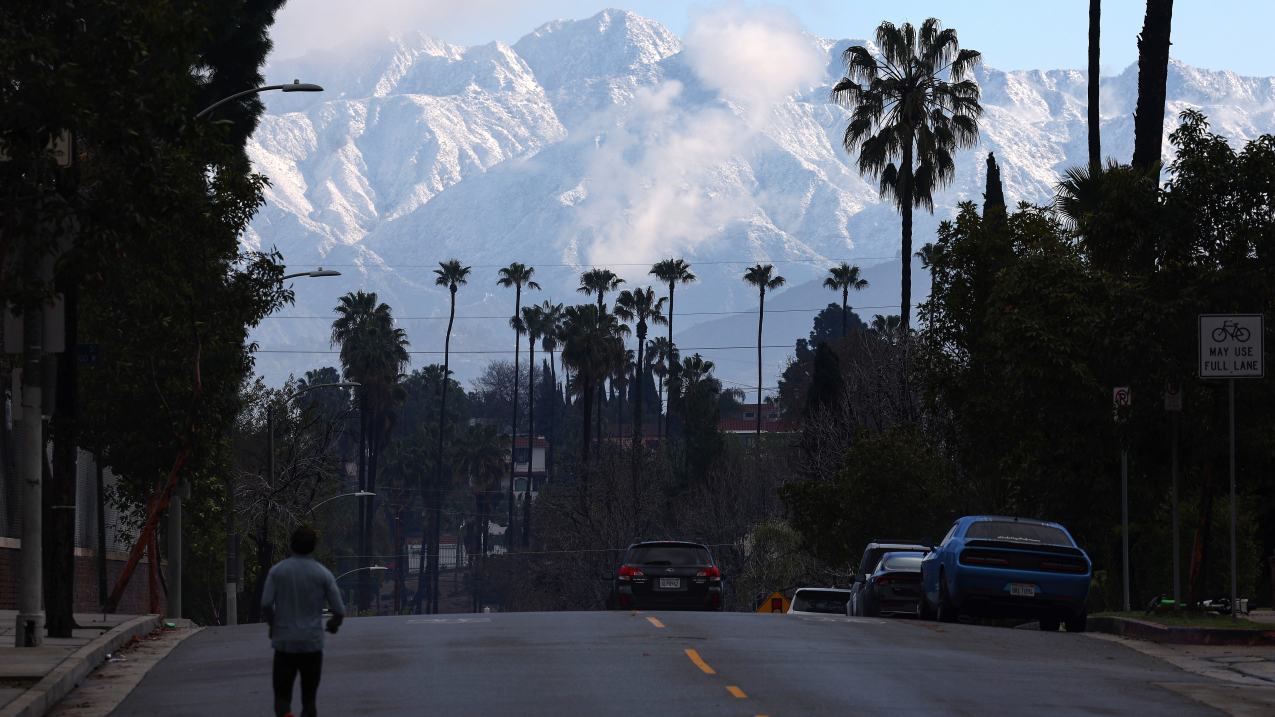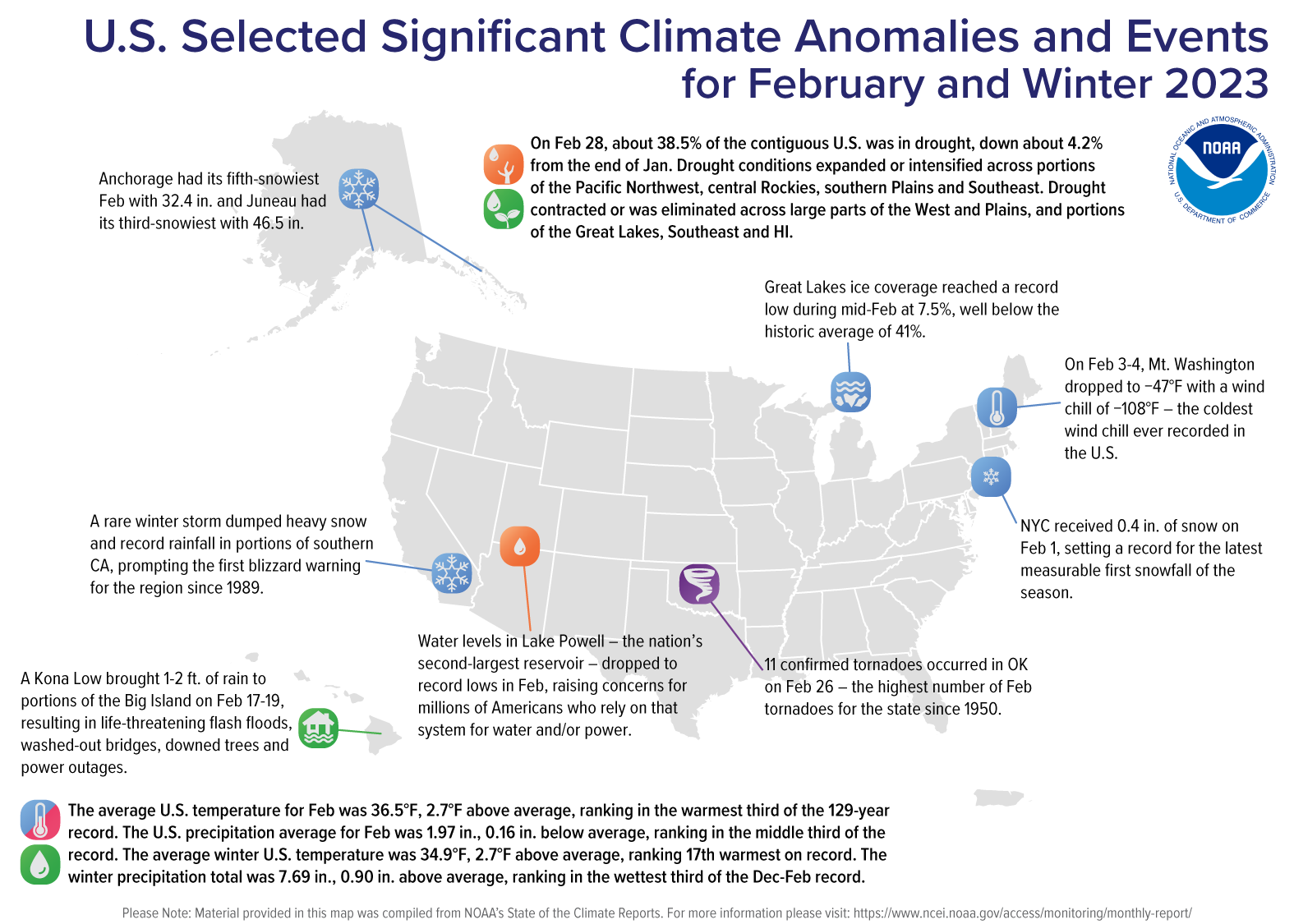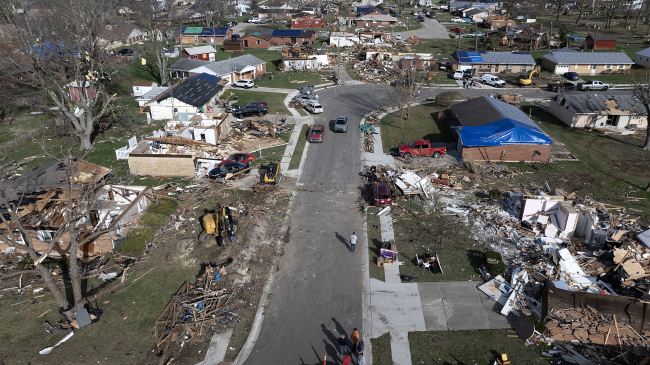Parade of winter storms put a big dent in California drought

A person jogs as palm trees stand in front of snow-covered San Gabriel Mountains following a powerful winter storm on February 26, 2023, in Los Angeles. The major storm prompted the first blizzard warning for parts of Southern California since 1989 and was among a series of storms that helped put a dent in California’s drought conditions. (Image credit: Mario Tama/Getty Images)
February continued the unusually mild start to 2023, with much of the eastern U.S. seeing record or near-record warm temperatures.
In the West, several storms brought historic wintry weather and continued to ease drought conditions in California, according to NOAA’s National Centers for Environmental Information (NCEI).
Below are highlights from NOAA’s U.S. climate report for February 2023:
Climate by the numbers
February 2023
The average temperature across the contiguous U.S. last month was 36.5 degrees F, 2.7 degrees above the 20th-century average, ranking in the warmest third of the 129-year climate record.
Virginia had its warmest February on record, while Georgia, Kentucky, Maryland, North Carolina, Ohio, Pennsylvania, South Carolina and West Virginia all saw their second-warmest Februaries. Delaware, Florida and Tennessee ranked third warmest, with nine additional states experiencing a top-10 warmest February on record.
February precipitation for the contiguous U.S. was 1.97 inches, 0.16 of an inch below average, ranking in the middle third of the record.
Connecticut and Rhode Island both experienced their seventh-driest February while Massachusetts ranked as the eighth driest. On the wetter side, Wisconsin ranked fifth wettest while Iowa and Michigan had their eighth-wettest and 10th-wettest Februaries on record, respectively.
Meteorological winter (December through February)
Meteorological winter was quite mild across the contiguous U.S. The average temperature was 34.9 degrees F — 2.7 degrees above average — ranking as the 17th warmest on record. Massachusetts had its warmest winter on record while Connecticut, Kentucky, Maryland, New Jersey, Ohio, Virginia and West Virginia saw their second-warmest winters. Twenty-one additional states saw their top-10 warmest winter seasons on record.
Total winter precipitation was 7.69 inches, 0.90 of an inch above average, ranking in the wettest third of the December-through-February record. Wisconsin had its wettest winter on record, Minnesota saw its second wettest and Iowa had its fourth wettest. Nebraska, Nevada, South Dakota and Utah had a top-10 wettest winter season while no state experienced a top-10 driest winter.

Other notable climate events
Winter weather lashed both coasts: From February 3-4, a polar vortex accompanied by powerful winds swept across portions of the Northeast resulting in dangerously low temperatures, power outages and canceled flights. On February 3, the temperature at Mount Washington, New Hampshire, dropped to -47 degrees F, with a wind chill of -108 degrees F—the coldest wind chill ever recorded in the U.S. In the West, a rare winter storm dumped heavy snow and record rainfall on portions of Southern California, prompting NOAA’s National Weather Service to issue the first blizzard warning for the region since 1989.
Severe weather struck parts of the nation: February 2023 had several notable weather systems that brought severe thunderstorms and an unusually high number of tornadoes to portions of the U.S. Three separate tornado outbreaks raked portions of the South and Midwest, as a rare EF-2 tornado touched down in central New Jersey on February 21. This was the first February tornado to hit the state since 1999 and only the fifth since 1950.
Drought conditions improved overall: According to the February 28 U.S. Drought Monitor report, about 38.5% of the contiguous U.S. was in drought, down about 4.2% from the end of January. Since January, a series of storms have brought record amounts of rain and snow to California, improving the state’s drought coverage from 98% on January 3 to 49% on February 28.
More > Access NOAA’s latest climate report and download the images.



